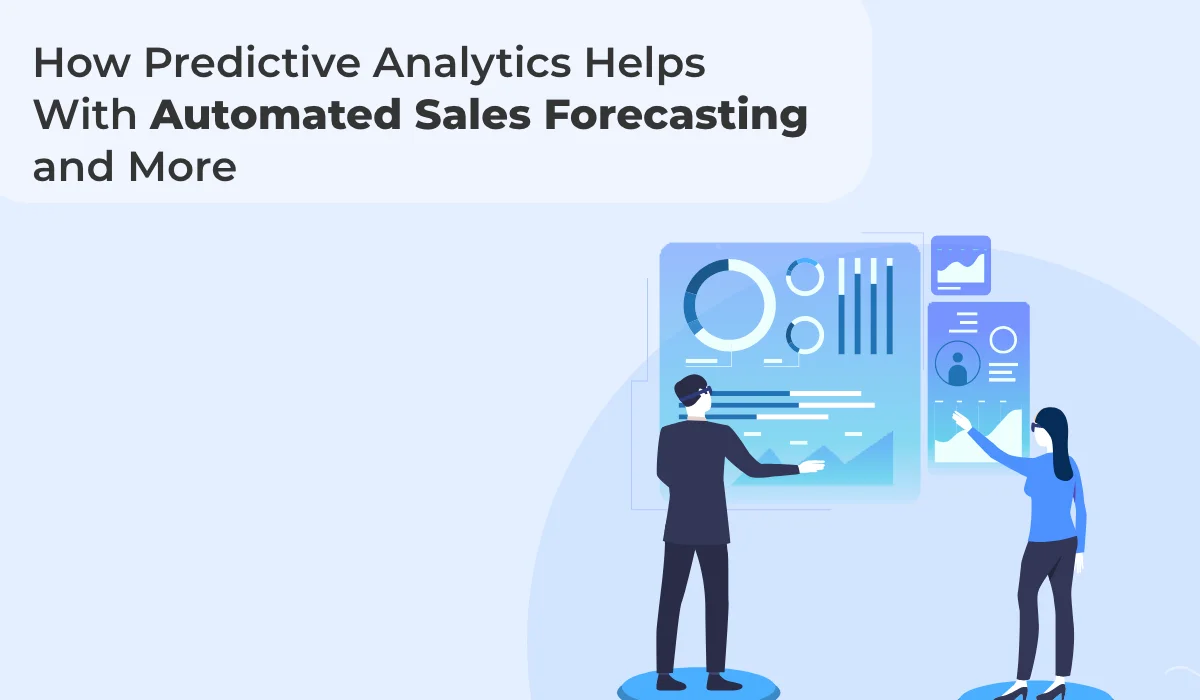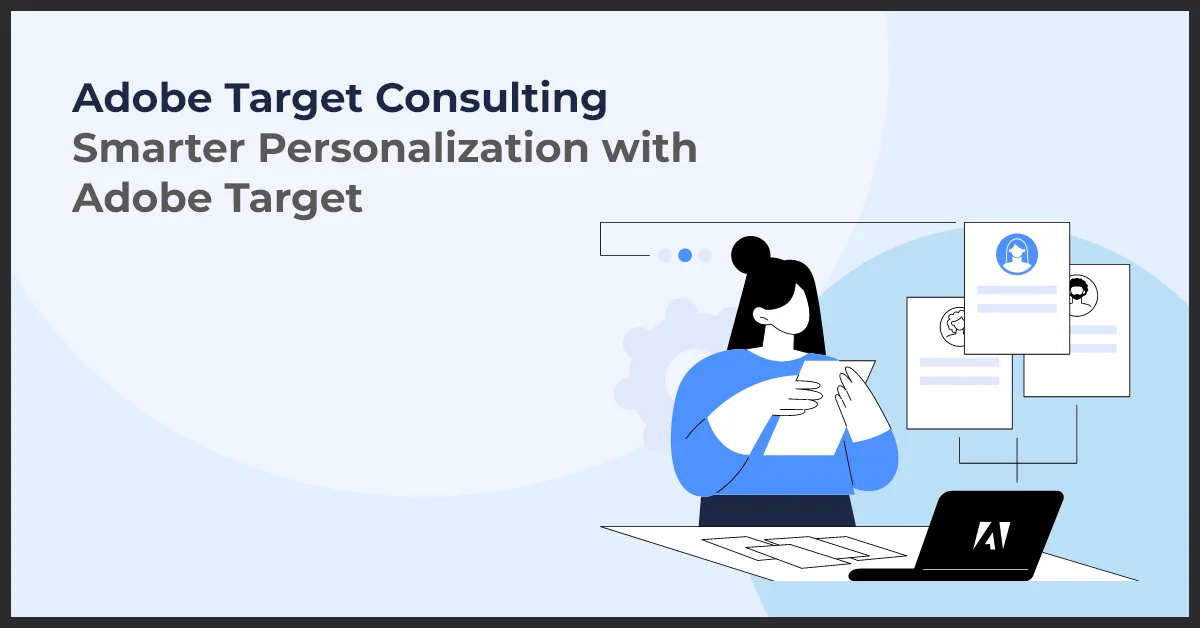How Predictive Analytics Helps With Automated Sales Forecasting and More

Published on: June 10, 2022
Updated on: October 24, 2024
2412 Views
- Analytics
16 min read
Did you know that the global predictive analytics market is expected to reach $35.45 billion by 2027, growing at a CAGR of 21.9% between 2020 and 2027?
If that doesn’t sound startling enough, how about more than 50% of top businesses using predictive analytics as a key tool in decision making?
As automation and artificial intelligence (AI) take center stage in business decisions, more organizations are using predictive analytics to forecast sales, increase profits, and streamline their operations.
Sales forecasting is seeing wide use of predictive analytics. It is estimated that an average salesperson spends more than 2.5 hours every week projecting sales. However, without a data-driven approach, 75% of those projections are likely to be inaccurate.
The use of predictive analytics can turn the tables and let businesses make smarter decisions, not only related to sales forecasting but also budgeting, setting goals, and prospecting. In this write-up, we shall see what sales forecasting with predictive analytics looks like, its benefits, and practical application in the industry.
What Is Predictive Analytics?
Predictive analytics is the use of data, stats, modeling techniques, algorithms, and machine learning to evaluate the likelihood of future outcomes based on current and historical data. Instead of the traditional approach to analytics that is focused on analyzing past data and evaluating performance, it is a forward-thinking approach. In technique, historical data helps in gaining insights into the future.
Sales forecasting is one of the best and most widely used applications of predictive analytics. This approach can help better anticipate the behavior of the target audience, understand their changing aspirations, and improve marketing campaigns for higher conversions.
Understanding Sales Forecasting
Sales forecasting plays a crucial role in the success of any business. It involves predicting future sales based on historical data and market trends. By accurately forecasting sales, businesses can make informed decisions about resource allocation, budgeting, and goal setting.
Definition and Purpose of Sales Forecasting
Sales forecasting is the process of estimating future sales volumes and revenues. It helps businesses plan their sales strategies, set sales targets, and evaluate their performance. By understanding the demand for their products or services, businesses can effectively manage inventory, production, and marketing efforts.
Types and Methods of Sales Forecasting
There are various types and methods of sales forecasting. Some common approaches include:
- Time Series Analysis: This method uses historical sales data to identify patterns and trends over a certain period of time. It is useful for forecasting short-term sales.
- Qualitative Forecasting: This approach relies on expert opinions, market research, and customer feedback to predict future sales. It is particularly useful when historical data is limited or unreliable.
- Regression Analysis: By analyzing the relationship between sales and various factors such as pricing, marketing expenditure, and economic indicators, regression analysis can provide quantitative forecasts.
Pro Tip: Choose the right forecasting method based on your data availability and business needs. Time series is ideal for trend analysis, qualitative forecasting excels with expert insights, and regression analysis offers data-driven accuracy.
Role of Data Analysis in Accurate Sales Forecasting
Data analysis is a critical component of accurate sales forecasting. By analyzing large datasets, businesses can identify patterns, correlations, and trends that may impact sales. Advanced data analysis techniques, such as predictive analytics, can help businesses make more accurate forecasts by leveraging historical data, market trends, and external factors.
Predictive Analysis – WHY and HOW
Before we delve into the benefits of predictive analytics, it is important to understand the ‘WHY’ and the ‘HOW’ behind this approach. The biggest motivation behind the use of this technique is to improve the accuracy of sales forecasts and reduce the scope for error.
Predictive analytics lets organizations adopt a fully automated sales forecasting process with the use of real-time data. This allows businesses to spot emerging opportunities early and at the same time, use resources better for improved productivity.
Benefits of Using Predictive Analytics
Predictive analytics involves analyzing large volumes of data to ensure improved decision-making. It helps organizations go beyond what happened and gain insights into the opportunities and risks for the future. This is why it’s important that you employ this process to automate sales forecast and other areas:
- Accurate Sales Forecast – Did your sales go up during the last holiday season? Are your production unit, warehouses, and supply chain geared up to meet the potential increase in demand?
This technique can help study the micro and macro factors in your sales forecast. Your business would be in combat mode to fight competition and leverage the upcoming opportunity.
- Know Your Customers – The buying patterns and aspirations of customers can change without warning and the inability to map these changes can lead to your downfall. Remember Kodak, Nokia, and Blackberry? Thus, it is important to identify the pattern in sales and know the aspirations of your existing and potential customers.
With predictive analytics, you will understand your customers and their changing aspirations. This allows you to meet them and remain competitive in the market.
- Augment Campaign Management – Marketing campaigns play a key role in your organization’s growth. Using this process, you will be able to identify KPIs such as campaign engagement, conversion rates, and campaign visibility. All of these help in improving the success of your marketing campaign and meeting end goals.
- Improve Customer Satisfaction – The inability to satisfy customers can be the greatest undoing for any business. It is important to keep customers happy and engaged, resolve their problems, and assert the benefits they enjoy in this relationship.
This advanced statistical technique can help you plan your marketing strategy to keep the customers engaged and maintain a high retention rate.
- Identify and Mitigate Risks – In a dynamic world, your organization will always face headwinds. Rising energy prices, global conflicts, and lack of access to raw materials are some of the risks that most global businesses face. It is important to identify these risks beforehand and mitigate them in time to remain competitive in the game.
- Improve Asset Utilization – Optimal asset utilization can help businesses reduce operational costs and increase profits. With predictive analytics, you can achieve this as it offers deep insights into the utilization of human and non-human assets. Based on past data, you can easily identify and address the bottlenecks in the business processes.
Examples of Predictive Analytics in the Industry
Today, businesses across industries use predictive analytics. Let us look at some examples to see how different industries are using this technique to increase sales and mitigate risks.
Ecommerce
This industry sees the widest use of predictive analytics. For instance, while buying a printer you might come across a combo package with ink supplies bundled under “Frequently bought together”. It is known as cross-selling where analytics uses buyer habits to come up with suggestions of products that are bought together. Online stores also use customers’ browsing history to create product bundles with additional discounts in what is termed as up-selling.
Banking & Financial Services
When billions of dollars are at stake, banks and financial institutions cannot afford to not dig deep into data. Predictive analytics is widely used to track the credit history of clients, reduce fraud, and retain valuable customers. For instance, most banks and other lenders use Credit Scores to judge the creditworthiness of individuals and businesses. Similarly, the launch of new and much-awaited vehicles can help these institutions predict an uptake in their financing products.
Retail
The retail industry especially in FMCG and fashion segments make use of predictive analytics to forecast sales and business. From price optimization to product suggestions and understanding the aspirations of the customers to offer loyalty programs, historical data is used to gain insights and improve brand loyalty. This allows retail businesses to better target their audience in online and offline communication. For example, a 20% discount coupon on diapers to a customer buying baby food ensures a higher conversion rate than distributing such coupons randomly to every single customer in a big mall.
Manufacturing
The manufacturing industry is using predictive analytics in multiple ways. Like most other businesses it is used to study the upcoming demand and align the production to meet these demands. Apart from these benefits, analytics also helps businesses mitigate the risks associated with poor-quality products, breakdowns, and delays.
Insurance Business
The speed of claim settlement is one of the biggest drivers of growth in the insurance business. Major insurers around the world rely on data mining and statistical modeling to automate various stages of claim settlement. For example, predictive analytics can raise red flags in case of potential fraud and this reduces manual intervention that would otherwise go toward scrutinizing every single claim to detect frauds.
Introduction to Salesforce
Salesforce is widely recognized as one of the leading Enterprise Cloud CRM platforms available in the market today. With its robust set of features and functionalities, Salesforce offers sales teams a comprehensive solution for managing customer data and sales pipelines.
Overview of Salesforce as an Enterprise Cloud CRM platform
Salesforce is designed to be a versatile and scalable platform that caters to the needs of businesses of all sizes. Whether you are a small startup or a multinational corporation, Salesforce provides a wide range of tools and capabilities to streamline sales processes and drive revenue growth.
As an Enterprise Cloud CRM platform, Salesforce offers a centralized hub for storing and managing customer data. This allows sales teams to have a holistic view of each customer, enabling them to understand their needs and preferences better. With this information at hand, sales professionals can deliver personalized interactions and tailor their sales strategies accordingly.
Key features and functionalities of Salesforce for sales teams
Salesforce comes with a host of features that empower sales teams to work more efficiently and effectively. Some of the key features include:
- Lead Management: Salesforce allows sales teams to capture, track, and manage leads throughout the entire sales cycle. This feature enables sales professionals to prioritize their efforts and focus on leads that are most likely to convert into customers.
- Opportunity Management: Salesforce provides a comprehensive view of each sales opportunity, allowing sales teams to track their progress and collaborate more effectively. This feature helps sales professionals make informed decisions and move deals forward.
- Sales Analytics: With Salesforce's robust analytics capabilities, sales teams can gain valuable insights into their sales performance. By analyzing data and generating reports, sales professionals can identify trends, forecast future sales, and make data-driven decisions.
- Mobile Accessibility: Salesforce offers mobile apps that enable sales teams to access customer information and collaborate on the go. This feature enhances productivity and allows sales professionals to stay connected with their customers at all times.
How Salesforce helps in managing customer data and sales pipelines
Managing customer data and sales pipelines can be a complex and time-consuming task. This is where Salesforce shines, providing a comprehensive solution for organizing and tracking these crucial aspects of sales processes.
With Salesforce, sales teams can easily capture and store customer data in a centralized database. This ensures that all relevant information is readily accessible and up to date. Additionally, Salesforce allows for easy segmentation of customer data, enabling sales teams to target specific audiences with personalized messages and offers.
Furthermore, Salesforce provides a clear overview of the sales pipeline, allowing sales professionals to visualize the progress of each deal. This visibility enables better forecasting and facilitates effective sales management. By tracking the various stages of the sales process, sales teams can identify bottlenecks, address any issues, and ensure timely follow-ups.
Predictive Analytics and Forecasting Techniques
Predictive analytics is a powerful technique that can greatly enhance sales forecasting. It involves analyzing historical data, identifying patterns, and using those patterns to make predictions about future sales trends. By leveraging predictive analytics, businesses can make more accurate forecasts, effectively plan their sales strategies, and ultimately improve their bottom line.
There are several techniques commonly used in predictive sales forecasting:
- Time series analysis: This technique involves analyzing historical data over a period of time to identify seasonality, trends, and other patterns that can be used to predict future sales.
- Regression analysis: Regression analysis involves analyzing the relationship between different variables, such as sales and advertising expenditure, to make predictions about future sales based on those variables.
- Forecasting models: These models use mathematical algorithms to analyze historical data and make predictions about future sales. They take into account various factors such as market conditions, customer behavior, and external influences.
- Data mining: Data mining involves extracting valuable insights and patterns from large datasets to make accurate predictions about future sales trends.
Artificial intelligence (AI) and machine learning (ML) play a crucial role in predictive forecasting. AI and ML algorithms can process vast amounts of data, identify patterns, and make predictions with a high level of accuracy. With the help of AI and ML, businesses can automate their forecasting processes, eliminate guesswork, and make data-driven decisions.
Salesforce Predictive Forecasting Features
When it comes to sales forecasting, Salesforce offers a range of powerful features that can take your predictions to the next level. Here, we will explore some of the key capabilities of Salesforce's predictive forecasting:
Detailed explanation of Salesforce's predictive forecasting capabilities
Salesforce's predictive forecasting goes beyond traditional methods, leveraging advanced algorithms and machine learning techniques to provide accurate and insightful predictions. With Salesforce, you can analyze historical data, identify patterns, and make data-driven forecasts that align with your business goals.
How Salesforce uses predictive analytics to forecast sales and revenue
Salesforce utilizes predictive analytics to analyze various factors that influence sales and revenue. By analyzing historical data, market trends, customer behavior, and other relevant variables, Salesforce can generate accurate forecasts and predictions. This enables businesses to make informed decisions and drive revenue growth.
The importance of accurate data input for improved predictions
In order to achieve accurate predictions, it is crucial to ensure that the data input into Salesforce is of high quality and relevance. Salesforce's predictive forecasting features rely on clean and comprehensive data to generate reliable forecasts. By maintaining accurate records and regularly updating data, businesses can enhance the precision of their predictions and improve overall forecasting accuracy.
Benefits of Salesforce Predictive Forecasting
Implementing Salesforce Predictive Forecasting brings several benefits to businesses looking to enhance their sales and revenue accuracy:
- Increased sales and revenue accuracy through predictive forecasting: Salesforce Predictive Forecasting leverages advanced algorithms to analyze historical data and make accurate predictions. This helps businesses make informed decisions, improve sales forecasts, and ultimately increase sales and revenue.
- Enhanced sales performance tracking and management: With Salesforce Predictive Forecasting, businesses can track and analyze the performance of their sales teams. Real-time insights and metrics enable managers to identify areas of improvement and provide targeted coaching to boost sales performance.
- Improved sales pipeline management and deal closing efficiency: Salesforce Predictive Forecasting allows businesses to effectively manage their sales pipelines. By predicting which deals are most likely to close, companies can prioritize resources and focus on high-value opportunities, increasing deal-closing efficiency and maximizing sales outcomes.
Pro Tip: Leverage Salesforce Predictive Forecasting to enhance your sales strategy. Use its insights to identify high-value opportunities, prioritize your sales efforts, and refine your coaching methods, ultimately driving improved performance and closing efficiency.
Future Trends in Predictive Forecasting
As technology continues to evolve at an exponential rate, predictive forecasting is expected to undergo significant advancements in the near future. These advancements will revolutionize the way businesses forecast sales and make informed decisions.
Emerging technologies and advancements in predictive forecasting
New technologies are constantly emerging, providing businesses with more accurate and efficient predictive forecasting capabilities. Machine learning algorithms, for example, can analyze vast amounts of data and identify patterns and trends that humans may overlook. This can lead to more accurate sales predictions and better decision-making.
The Internet of Things (IoT) is another emerging technology that can contribute to more reliable predictive forecasting. By connecting various devices and collecting real-time data, businesses can gain deeper insights into customer behavior and preferences, enabling them to make more accurate sales forecasts and tailor their strategies accordingly.
The role of AI and machine learning in the future of sales forecasting
Artificial Intelligence (AI) and machine learning are expected to play a crucial role in the future of sales forecasting. These technologies can analyze large datasets and generate accurate sales predictions based on numerous variables, such as customer behavior, market trends, and historical data.
AI-powered predictive forecasting tools can automate repetitive tasks, allowing sales teams to focus on more critical activities. By leveraging AI and machine learning, businesses can improve their sales forecasting accuracy, reduce errors, and increase overall productivity.
Predictions and expert insights on the future of Salesforce's predictive capabilities
Industry experts predict that Salesforce's predictive capabilities will continue to evolve and become more sophisticated. The company's commitment to innovation and research ensures that users can expect continuous improvements and advancements in their predictive forecasting features.
Experts anticipate that Salesforce will integrate more AI and machine learning algorithms into their predictive forecasting tools, enabling businesses to obtain even more accurate sales predictions. Additionally, Salesforce may incorporate advanced visualization techniques that allow users to easily interpret and analyze sales forecasting data.
With ongoing advancements and expert insights, Salesforce is poised to remain at the forefront of predictive forecasting, enabling businesses to make data-driven decisions and stay ahead of the competition.
Key Takeaways
- Predictive analytics helps businesses forecast future sales and improve decision-making based on historical and current data.
- Sales forecasting benefits from predictive analytics by increasing accuracy in predicting customer behavior and market trends.
- Predictive analytics enhances marketing efforts through improved campaign management and customer engagement.
- It aids in identifying risks and optimizing resource utilization, improving overall business efficiency.
- Salesforce provides robust tools for predictive forecasting that drive better sales management and revenue growth.
Conclusion
Predictive analytics opens several possibilities for your organization. It can revitalize your sales forecasting process and provide you with new opportunities for the growth and transformation of your business. It speeds up decision-making and lets your organization snatch the initiative in a highly competitive market.
Source:
Frequently Asked Questions
By analyzing historical data, predictive analytics helps businesses forecast future trends, demand, and customer behavior, enabling more accurate decision-making and strategic planning.
Industries like retail, finance, healthcare, manufacturing, and e-commerce benefit significantly from predictive sales forecasting, which improves inventory management, resource allocation, and customer engagement.
Predictive analytics increases ROI by optimizing resource use, reducing risks, improving conversion rates, and enabling more accurate sales predictions, leading to better strategic decisions.
Predictive analytics can personalize the sales process by analyzing customer preferences, behaviors, and buying patterns to tailor product recommendations and communication.
The future of predictive analytics in sales includes more AI-driven insights, real-time data analysis, enhanced personalization, and seamless integration across sales and marketing platforms.
Predictive analytics improves performance by identifying opportunities, detecting risks, optimizing processes, and providing actionable insights for better decision-making and resource allocation.



